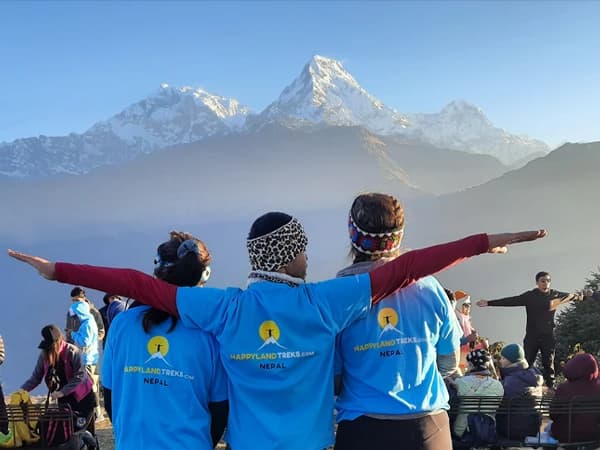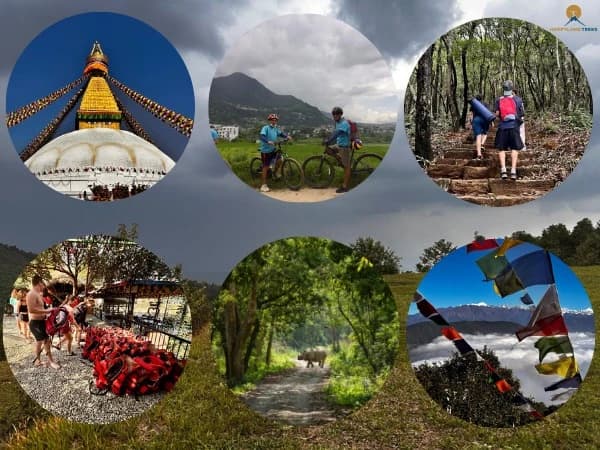What Makes Spring The Best Time For The Everest Base Camp Trek in Nepal?
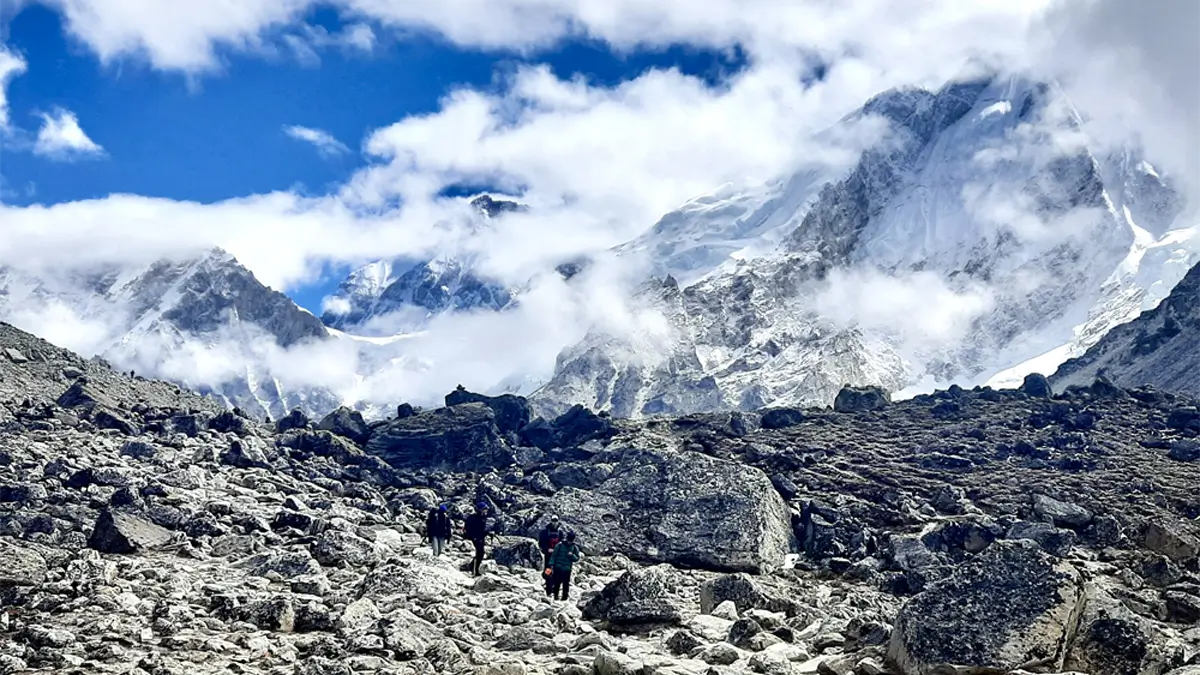
Stable Weather & Favourable Temperatures
Here’s the real perk of choosing Everest Base Camp in Spring: the Himalayan skies stay remarkably clear, especially in the mornings, due to stable atmospheric conditions and low humidity. That means you will wake up to crisp, bluebird mornings and unbeatable mountain views.
Daytime visibility is outstanding, which is perfect for catching sunrises over Everest and Ama Dablam without the haze or snowfall.
Down at the lower altitudes, you will feel a comfortable 10 °C to 20 °C (50 °F to 68 °F) during the day and a refreshing 0 °C to 5 °C (32 °F to 41 °F) at night. As you head higher toward Everest Base Camp, it cools off around 5 °C to 10 °C (41 °F to 50 °F) during the day and a brisk −5 °C to −10 °C (14 °F to 23 °F) after dark.
Altogether, Spring trekking feels balanced. March gives you that crisp alpine chill, while late April into May warms things up just enough for lighter layers. And those cold, dry nights? They are perfect for stargazing.
In fact, there is less snow and fewer weather delays for flights to Lukla that gives you a predictable outcome.
Rhododendron Blooms, Flora & Wildlife Highlights
If you are hiking to Mount Everest Base Camp in Spring, the landscape just explodes with colour. All the hills and forested trails are filled with rhododendron blooms in reds, pinks, and this creamy white.
Rhododendrons are basically Nepal’s national pride, and honestly, when you see those forests flexing all those shades, it’s hard not to get a little emotional. Plus, if you are into wildlife, there is way more than just flowers trying to steal the show up there.
As you ascend, the beautiful and dense pine and oak forests will give way to alpine meadows.
Here, the meadows will be sprinkled and dominated by junipers. Rhododendron, the Himalaya blue poppy, snow lotus, edelweiss, and primulas all add beauty in the form of a flower. If you enjoy talking to people, go and ask about Yarsagumba.
It is a rare and prized caterpillar fungus, which is known for its healing and medicinal properties.
Spring is the peak season for wildlife in the region. While in the meadows, you may see a musk deer, golden eagles, and the national bird, the Himalayan monal.
If the creatures of the wild allow, you may see a snow leopard. Even smaller beasts, such as the yellow-throated martens and mountain weasels, will keep you entertained.
Here is my pro tip: When going on your own adventure, it is best to do it early. The first few hours of the day, especially in April and May, are the most precious for birdwatching and for the activities of different wildlife.
Safer Trail Conditions & Lukla Flight Reliability
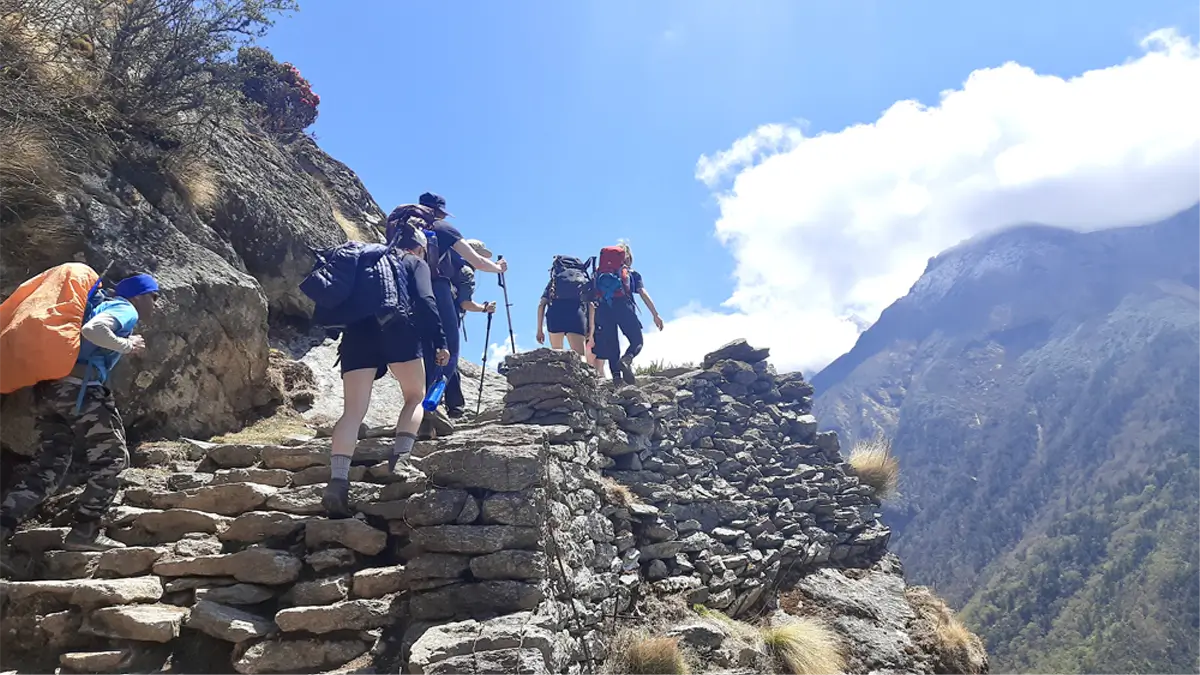
Trekking to Everest during Spring is quite pleasant and safe. March still hides a few potentially dangerous icy patches above 4,500 meters after a long Winter, but most of the path is dry, firm, and beautifully stable during April and May.
Compared to the muddy trails of the Monsoon months and the knee-deep snow of Winter, Spring is quite pleasant. The Spring dry surface is also much easier to trek on, whether you are a first-timer or a seasoned trekker, and you will have a decreased chance of slipping and getting tired.
Of all the flights to Lukla, the entrance to Everest Base Camp, Spring delivers the best weather. The mornings are stable, the skies are clear, and the clouds are fewer, all of which mean much lower chances of flights getting delayed or cancel.
Spring gives you much lower stress on a tight schedule and delivers you a safer trek compared to the other seasons.
Scenic Suspension Bridge Crossings Including the Edmund Hillary Bridge
Day two on the EBC trek is when things start to get real. You are weaving across all these suspension bridges, the wobbly kind that make your knees a little weak and your heart go, “Uhh, are we sure about this?”
One of the highest suspension bridges is the Edmund Hillary Suspension Bridge, nestled right between Lukla and Namche Bazaar. It’s, like, the unofficial welcome mat to Namche Bazaar.
This bridge is named after the legend himself, Sir Edmund Hillary, and is basically a rite of passage. It’s 50 meters of steel and wood stretched over the wild Dudh Koshi River. And let me tell you, it moves enough that when a yak train comes rumbling past or the wind decides to show off. Every step feels like a mini-adventure.
If you are lucky and it’s Spring, you are in for a treat. There are crystal clear blue skies, sharp air, and warm sunlight.
The gorge walls climb up on both sides, and pine forests are sprinkled with rhododendrons. All around, you will also see prayer flags and khada scarves.
Moving on, this isn’t the only suspension bridge adventure on the trek. Between Phakding and Namche Bazaar, you will cross five or so bridges. It includes truss bridges over streams and simpler wooden or wire-decked crossings near Benkar and Jorsalle.
And it’s not just about this one bridge. Every crossing throws a new view at you with waterfalls crashing down, deep green valleys, or just endless sky. You can stop for a second, snap a pic, and let it sink in. Don’t rush. Seriously, watch your step and soak it all up.
Views from Kalapathar
Optimal Visibility: Spring (March to May) offers clear skies and reduced snowfall.
Moderate Temperatures: Milder temperatures compared to winter make the ascent more comfortable.
Stable Weather: Consistent weather patterns in spring contribute to fewer clouds and better viewing conditions.
Photographic Opportunities: The spring light and clear air provide excellent conditions for photography.
Mountains: Mount Everest (8,848 meters), Lhotse (8,516 meters), Nuptse (7,861 meters), Pumori (7,161 meters), Ama Dablam (6,812 meters), & Khumbu Glacier.
Sunrise: Witness the first light illuminating Everest and the surrounding peaks, creating a golden glow.
Sunset: Evening light casts dramatic shadows and colors on the mountains, offering stunning views.
Photography Tips: Capture the changing light conditions; early morning and late afternoon provide the best lighting for landscape photography.
Festivals & Cultural Highlights
Springtime on the EBC trek is when Khumbu really wakes up. The whole place buzzes as tea houses are full, and the trails are clear, so you can actually see folks living their lives. Namche Bazaar and Tengboche, especially, feel like the heartbeat of the whole Sherpa life.
This is also the jackpot season for the celebrations. If you are lucky (and time it right), you will stumble into Buddha Jayanti or Buddha Purnima.
It usually hits in April or May, and you will get to see monks chanting, butter lamps flickering, and incense weaving through the air. It’s wild how peaceful it is, honestly. The whole scene feels like something out of a movie.
Oh, and don’t even get me started on the Nepali New Year, Nepal Sambat. It is celebrated during the Mid-April. If you are there in the middle of processions, you will notice the sound of drums, people dancing, and just a whole lot of pure joy.
Monasteries and prayer wheels get decked out with fresh flags and flowers. Everyone gets folded into the celebration. You might get roped into a blessing or two before you even know what’s happening.
And Tengboche Monastery? That place is next level. It’s like the spiritual engine of the whole Everest area.
If you are there for a festival, the courtyard fills up with monks doing these old-school rituals, and as you look up, you will find Ama Dablam in the background. Even the little gompas and stupas in Namche, Pangboche, Dingboche, and dotted along the trail turn into mini epicentres of action.
Crowd Levels & Best Time to Start Trek
Let’s be real, Spring on the Everest trek is prime time, and you are not the only one who knows it. From late March through May, the Khumbu trails buzz with trekkers chasing those crystal-clear skies and stable weather. (but one things you need to know weather in the mountain always changing)
Here, April is the hotspot, and you will find the paths between Lukla and Namche filled with hikers, porters, and yak trains loaded with gear. It’s lively and social, but if you are dreaming of solitude, you will need to plan smart.
Most tea houses along the Everest trail are fully open by March, but the best rooms with mountain views book fast. I always recommend reserving early, especially in Namche, Tengboche, Dingboche, Lobuche, and Gorakshep.
Also, Base Camp itself gets an extra surge of excitement because this is also Everest summit season. You will witness climbers and support teams setting up bright tents across the glacier. And watching that scene unfold is pretty inspiring, even if you are not climbing higher than Kala Patthar.
If you would like a quieter vibe without losing the Spring magic, you must aim for late March or the first week of April. You will still catch the rhododendron blooms and bluebird skies, but dodge the heaviest crowds.
Now, early March can feel a touch colder, while late May warms up with a hint of pre-monsoon clouds, so you must also weigh your comfort level.
How March, April & May Differ: Pros & Things to Know on the Everest trekking
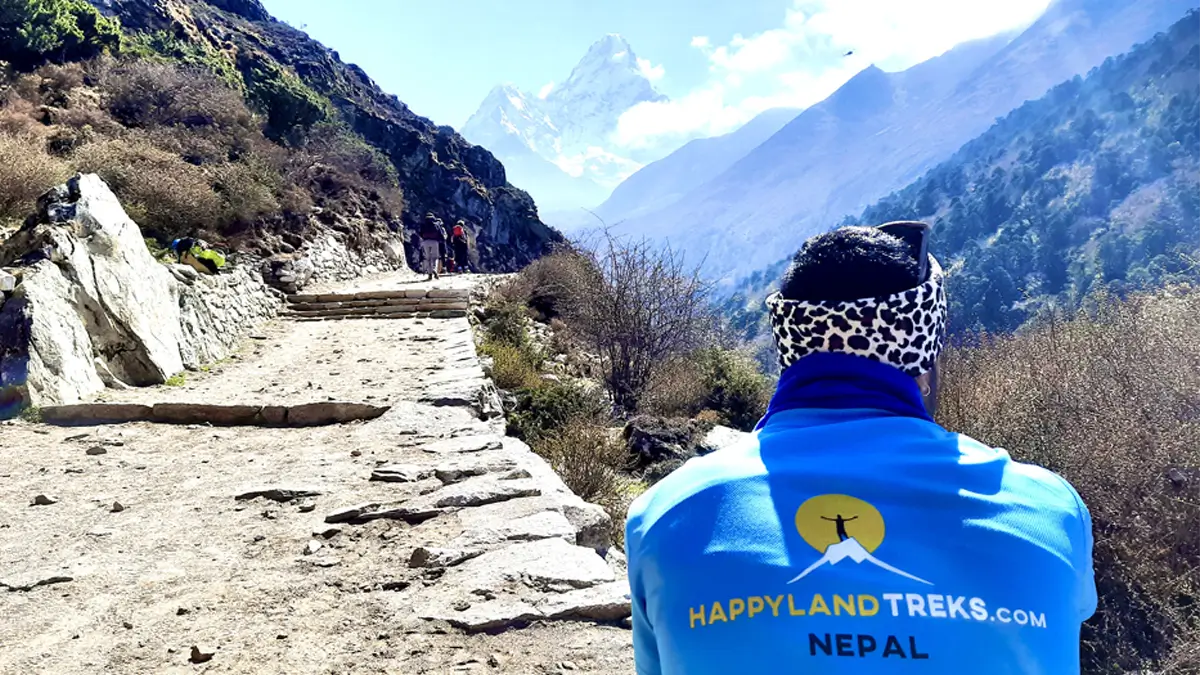
Spring on the Everest Base Camp trek offers unique highlights each month. March is crisp, quiet, and ideal for solitude, though nights are chilly and higher trails may still have ice.
April brings warmer weather, vibrant rhododendron blooms, and lively trails with festivals in full swing. May is the warmest, the Everest summit season peaks, and the trails buzz with energy. Your choice depends on whether you prefer fewer crowds, colourful landscapes, or the peak trekking vibe.
Everest Base Camp Trek in March
Early March still has lingering winter with light snow at higher elevations.
Trails start frozen and icy, especially above 4,000 meters.
Daytime temperatures range between 5°C and 10°C (41°F to 50°F), ideal for trekking.
Nighttime temperatures can drop to −8°C to −15°C (17°F to 5°F), requiring warm layers.
By mid-March, snow begins melting, trails become more stable and easier to walk.
Buds start to bloom, signalling the onset of spring in lower forests and valleys.
Clear skies provide excellent views of Everest, Lhotse, Ama Dablam, and surrounding peaks.
Lower altitude trails (Lukla, Namche Bazaar) are generally snow-free and accessible.
Higher elevation trails (Gorak Shep, Base Camp) may still have residual snow patches.
March has fewer trekkers, offering a quieter and more serene EBC experience in Spring.
Wildlife such as Himalayan tahr, pheasants, and birds start emerging from winter habitats.
Trek To Everest Base Camp in April
April is the peak Spring season for the Everest Base Camp trek with the best weather conditions.
Trails are stable and dry with minimal snow or rain.
Daytime temperatures range from 10°C to 15°C (50°F to 59°F), which is ideal for trekking.
Nighttime temperatures remain cool but generally above freezing.
Rhododendrons and other wildflowers are in full bloom.
Lower and higher elevation trails are mostly snow-free and easily navigable.
Clear skies provide unobstructed views of Everest, Lhotse, Ama Dablam, and surrounding peaks.
Higher crowds due to peak trekking season, offering a lively and social trekking experience.
Tea houses and lodges are fully operational and well-stocked, but reservations are recommended.
Wildlife like the Himalayan tahr, pheasants, and birds are active and more visible.
Stable weather improves flight reliability to and from Lukla.
Trekking is comfortable with minimal extreme cold or heat.
Acclimatization is easier due to moderate temperatures and consistent trail conditions.
Photography opportunities are excellent with clear skies and colorful scenery.
EBC Trekking in May
May marks the end of the Spring trekking season in the Everest region in Nepal.
Humidity increases by mid-May as the region approaches the pre-monsoon period.
Afternoon clouds may roll in, and light showers can occur, especially later in the month.
Few rhododendrons and other wildflowers are still in bloom.
Compared to April, May sees fewer trekkers.
Wildlife such as Himalayan tahr and pheasants remain active, though sightings may decrease at lower elevations.
Local festivals and cultural events may still occur.
Stable weather in early May contributes to reliable flights to and from Lukla.
Key Info’s to Plan for the Spring Trek to Everest Base Camp in Nepal
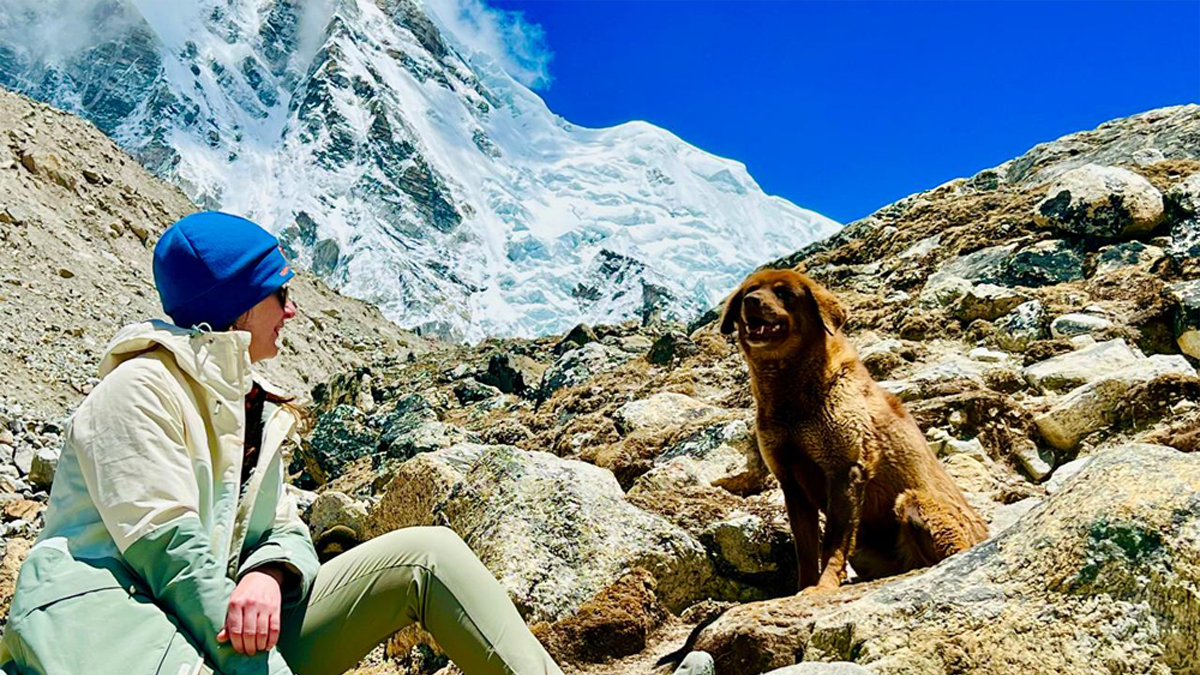
Logistics & Transport: Lukla Flights, Teahouses & Acclimatization
Now, here’s the deal: if you are dreaming about hitting Everest Base Camp in the Spring, you gotta get your logistics game on point, especially those flights to Lukla. Since Spring is a prime season, tickets vanish in a blink, and even after it, you may face weather and air traffic messing with your plans.
Hot tip: if your Lukla flight gets cancel (which may happen more than anyone likes to admit), you are stuck with the Ramechhap Plan B. However, you will need to brace yourself for a longer, bumpier ride.
Once you finally hit the trail, don’t expect a peaceful mountain village vibe. Places like Namche Bazaar, Dingboche, and Gorakshep; they may be packed with crowds. Therefore, booking ahead is a smart move to make. But walking trail is peaceful and peaceful mountain view.
Honestly, if you are trekking with a legit local trekking agency and a guide, planning gets way less stressful. They will hustle for your bookings, advise on acclimatization schedules, and generally save you from rookie mistakes.
Bottom line: Spring has the best weather and blue skies for Everest trekking; however, you will need to nail down flights, beds, and acclimatization before you go.
What to Pack: Spring-Specific Gear for the Everest Trek
Clothing & Footwear:
Layered clothing system: base layer, insulating layer, and outer shell for changing temperatures.
Moisture-wicking base layers made of merino wool or synthetic fabrics.
Lightweight fleece or down jacket for warmth during mornings and evenings.
Waterproof and windproof outer shell jacket to protect against spring showers and wind.
Convertible trekking pants
Lightweight thermal underwear
Sturdy, waterproof hiking boots with good ankle support.
Lightweight camp shoes or sandals for teahouses and lodges.
Moisture-wicking socks
Lightweight gloves for daytime trekking and insulated gloves for cold mornings/evenings.
Sun hat for daytime protection and a warm beanie or balaclava for early mornings.
Personal Items & Trekking Gear:
UV-protective sunglasses with side shields.
High-SPF sunscreen and lip balm for sun protection at high altitude.
3 to 4 litter hydration bladder or water bottles; water purification system optional.
Collapsible trekking poles for stability and reduced knee strain.
45 to 55L main backpack and 20 to 30L daypack for essentials.
3-season sleeping bag rated for temperatures as low as −10°C (14°F).
Reliable headlamp with extra batteries.
Personal items: toiletries, wet wipes, hand sanitizer, and a small first aid kit.
Snacks like energy bars, nuts, and dried fruits.
Camera gear: compact camera or smartphone with extra memory cards and a power bank.
Important documents: passport, trekking permits, and insurance in a waterproof pouch.
EBC Trek Budget & Costs: Lodging, Food & Permits in Spring
Alright, let’s get real, planning a Spring trek to Everest Base Camp isn’t exactly an easy adventure. Its prices can sneak up on you. If you are looking forward to a 14-day Everest trip, it will probably cost you somewhere in the ballpark of USD 1,650 per person.
That cost includes your flights, permits, your overnight accommodation, food, and a guide who actually knows where they are going.
Now, those little flights to Lukla? They are around USD 224 USD, so around 448 USD for a round trip, that’s including in a 1650 with trekking permit per person, but when you are traveling in the Spring, the seats can be fully booked faster.
Permits are non-negotiable, too: you will need the Khumbu Pasang Lhamu Municipality Entry permit and the Gaurishankar Conservation Area Permit from the lower region.
Tea houses, your home away from home, are actually not too shabby for the price (usually USD 9 to USD 200 a night unless you are in Namche Bazaar, where prices like to flex). As for food, you can count on cost USD 30 to 40 a day.
And unless you fancy carrying your entire life on your back, a guide or porter will run cost USD 35 to 70 (for guides) or USD 25 to 40 (for porters) per day.
Also, don’t forget the extras: special trekking insurance up to 5600m, (non-negotiable unless you think you are invincible), gear rental, and those little luxury upgrades.
Pro tip: book early, team up with a group, or go local with trekking agencies if you want your budget to last longer.
Seasonal Tips EBC Everest -Trek Nepal
Spend extra nights in key locations like Namche Bazaar (3,440 meters) and Dingboche (4,410 meters) to reduce the risk of altitude sickness.
Aim to drink 4 to 5 litters of water daily to stay hydrated, especially at higher altitudes.
Pack clothes in layers with only essential items.
Choose sturdy, waterproof trekking boots with good ankle support and break them in before the trek.
Ensure your policy covers high-altitude trekking, medical emergencies, and emergency evacuation.
Secure flights to Lukla and tea house accommodations in advance due to high demand during the Spring season.
Incorporate rest days into your itinerary to allow your body to adjust to the altitude.
Carry high-energy snacks like nuts, energy bars, and dried fruits to maintain energy levels.
Share your itinerary and emergency contact information with family or friends before departure.
Be prepared for sudden weather changes, including rain, snow, and strong winds, especially at higher Capture the stunning landscapes and cultural landmarks, but always ask for permission before photographing people.
Keep an eye out for wildlife such as yaks, Himalayan tahr, and various bird species along the trail.
Allow time for rest and recovery after the trek before continuing with other travel plans.
Keep updated on any changes in regulations, trail conditions, or weather forecasts before and during your trek.
Timing & Best Trekking Itinerary for Mt. Everest Base Camp in Spring
Alright, listen up, if you are planning that classic Everest Base Camp trek and want to catch it at its absolute finest, Spring is your golden ticket.
March rolls in, things are starting to wake up, but April is when the whole region just flexes. Flowers are most of the places in low land, the weather is actually cooperating, and the air is fresh as well as clean.
Now, honestly, at what time you hit the trail also matters. Early mornings are chef’s kiss, with cool air, not a cloud in sight, and excellent views of Everest, Lhotse, and Ama Dablam.
But by the time afternoon comes around, it’s a different story. The sun is out, and clouds start getting bold, especially if you are pushing your luck into late May. So yeah, plan your snack breaks and photo stops before the sky starts acting up. And lastly, in the evenings, especially the sunset from Kala Patthar, is different. If you are a sucker for epic photos, you will wanna stick around for that golden hour magic.
Recommended 14-Day Spring Itinerary
To make the most of spring, here is a tried-and-true itinerary for 14 days.
This itinerary is tailored for the Spring season, balancing acclimatization, scenic vistas, and cultural experiences:
Day 01: Arrival in Kathmandu (1,400 meters) and transfer to your hotel.
Day 02: Drive to Ramechhap and flight to Lukla, and trek to Phakding (2,652 meters) 3-4 hrs.
Day 03: Trek to Namche Bazaar (3,440 meters) 7 hrs.
Day 04: Rest day for acclimatization in Namche Bazaar, and hiking to Everest view hotel.
Day 05: Trek to Tengboche (3,800 meters) 5 - 6 hrs.
Day 06: Trek to Dingboche (4,210 meters) 6 - 7 hrs.
Day 07: 2nd acclimatization day in Dingboche.
Day 08: Trek to Lobuche (4,920 meters) 4 - 6 hrs.
Day 09: Trek to Gorak Shep (5,180 meters). After lunch, trek to Everest Base Camp (5,364 meters) and return to Gorak Shep 7 - 8 hrs.
Day 10: Hike to Kala Patthar (5,550 meters) for Everest sunrise view, and mountain vistas. Back to Gorakshep, then trek back to Pangboche (3,990 meters) 7 hrs.
Day 11: Trek back to Namche Bazaar (3,450 meters) 6 - 7 hrs.
Day 12: Trek back to Lukla (2,840 meters) 7 – 8 hrs.
Day 13: Morning flight back to Kathmandu; free afternoon.
Day 14: Departure for home or you can stay longer.
Group Vs. Private Guided Tour for the Spring Trek to Everest Base Camp
So, are you eyeing Everest Base Camp this Spring? First thing you gotta figure out is whether to roll with a group or do a private tour. And yeah, it actually matters a lot. Spring’s the madhouse season.
The trails get packed, flights book out in a blink, and tea houses get full easily. Your call here basically makes or breaks whether your trip’s chill or a stress-fest.
If you go the group route, you will probably be with six to twelve folks from all over the map.
You get shared guides, porters, and pre-arranged tea house stays,. It’s perfect if you are solo or love meeting new people, plus the shared energy on the trail can make the long hikes feel easier.
However, with group treks, you will get less flexibility. You will need to follow the group’s pace, schedule, and itinerary, which may not always match your rhythm or photography stops.
On the flip side, a private trek gives you full control. You can choose your start date, pace, rest days, and even detours for viewpoints or local villages.
You will also have a dedicated guide and porter focusing solely on your needs, making acclimatization, no rush at all and walk on your peace. meals, and room choices more relaxed, and more private. It’s ideal for families, close friends, or anyone craving privacy and a tailored adventure.
So, no matter which you pick, you must go local. You must book with a locally owned trekking company. They ensure insider knowledge, smoother logistics, and your money directly supports the communities along the trail.
And whatever your choice, you must book early. Spring is busy, and flights, tea houses, and guides vanish fast. The right decision here sets the tone for a safe, memorable, and fully optimized Spring Everest Base Camp trek.
FAQs
What is the best month to trek the Everest Base Camp in Spring?
April is the best month for the EBC Everest trek with stable weather, clear skies, and blooming rhododendrons. However, even late March and early May also offer reliable trekking conditions with fewer crowds.
How crowded is the Everest Base Camp trail in march, april, and may?
April sees the highest foot traffic in the EBC trail as its peak trekking and climbing season, while March and late May bring slightly lighter crowds.
Are Lukla flights reliable during the spring trekking season?
Yes. Spring offers mostly stable flying conditions, but high demand means you will find limited seats.
How much does the Everest Base Camp trek cost in spring?
Budget around USD 1,650 – 2000 for a 14-day trek, covering flights, permits, guide and porter services, meals, and tea house lodging.
What are the daytime and nighttime temperatures in march, april, and may?
Daytime highs range from 10 °C to 15 °C, while nights can drop to –10 °C -105°C 20 °C at higher elevations.
How do festivals enhance the Everest Base Camp experience in spring?
You can witness Buddha Jayanti celebrations and Sherpa cultural events at monasteries like Tengboche.
Is a private or group trek better for Everest Base Camp in spring?
You can choose a group trek which is random trekkers and trekking with a group rules, or a private trek for more flexibility, solo chill, and walk on your custom pace, and more privacy and solo.







